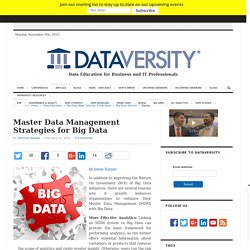

An Introduction to NoSQL Data Management for Big Data. Editor’s note: This article is part of a series examining issues related to evaluating and implementing big data analytics in business.
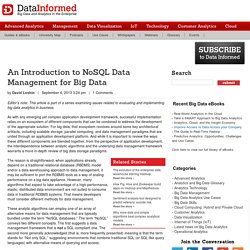
As with any emerging yet complex application development framework, successful implementation relies on an ecosystem of different components that can be combined to address the development of the appropriate solution. For big data, that ecosystem revolves around some key architectural artifacts, including scalable storage, parallel computing, and data management paradigms that are united through an application development platform. And while it is important to review the ways these different components are blended together, from the perspective of application development, the interdependence between analytic algorithms and the underlying data management framework warrants a more in-depth review of big data storage paradigms.
Related Stories The evolution of the enterprise data warehouse starring Hadoop. Figure 1: Example of document store. NoSQL Databases Defined & Explained. What is NoSQL?
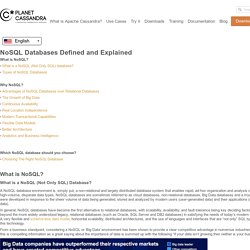
• What is a NoSQL (Not Only SQL) database? NoSQL Data Modeling Techniques. NoSQL databases are often compared by various non-functional criteria, such as scalability, performance, and consistency.
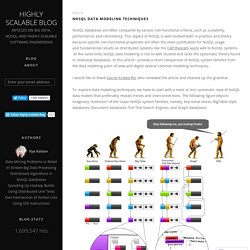
This aspect of NoSQL is well-studied both in practice and theory because specific non-functional properties are often the main justification for NoSQL usage and fundamental results on distributed systems like the CAP theorem apply well to NoSQL systems. At the same time, NoSQL data modeling is not so well studied and lacks the systematic theory found in relational databases. In this article I provide a short comparison of NoSQL system families from the data modeling point of view and digest several common modeling techniques. I would like to thank Daniel Kirkdorffer who reviewed the article and cleaned up the grammar. To explore data modeling techniques, we have to start with a more or less systematic view of NoSQL data models that preferably reveals trends and interconnections. Key-Value storage is a very simplistic, but very powerful model. Contemporary Trends in Master Data Management.
By Jelani Harper Master Data Management (MDM) is changing to reflect some of the more influential technologies in the Data Management space today, which includes Big Data, graph databases, Cloud Computing, social media, mobile, and others.
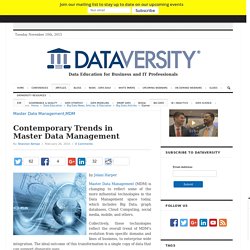
Collectively, these technologies reflect the overall trend of MDM’s evolution from specific domains and lines of business, to enterprise wide integration. The ideal outcome of this transformation is a single copy of data that can support disparate uses. Individually, these technologies are shaping various strategies for the deployment of MDM, which are largely based on those technologies themselves. Graphs. Why Graphs Are Essential To Today’s Master Data Management [NoSQL Now! Preview] By Aaron Wallace, Principal Product Manager, Pitney Bowes | August 14, 2015 Rapid change is the only constant in today’s business environment.
![Why Graphs Are Essential To Today’s Master Data Management [NoSQL Now! Preview]](http://cdn.pearltrees.com/s/pic/th/essential-management-preview-119567174)
The limitations of traditional tools used for information and master data management (MDM) are increasingly exposed, and the graph database is a solution to many of these challenges and presents a new, unique way to improve on these practices. Why Master Data Management Matters Customer information management and master data management lie at the center of any successful business. Without an understanding of the various sources of customer data, an ability to qualify and integrate these sources and an ability to make this information available to the business – most customer-focused initiatives will stumble, sometimes never realizing the initial vision of the project. Current technologies frequently fall short when attempting to address these challenges. Why Relational Databases Aren’t Enough for MDM Enter the graph database. Conclusion. The dirty truth about big data and NoSQL. If I asked you for the defining characteristic of a big data customer, you'd probably say they're sitting on large amounts of data.
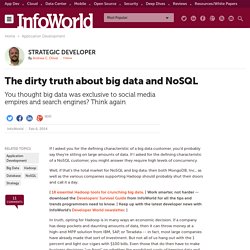
If I asked for the defining characteristic of a NoSQL customer, you might answer they require high levels of concurrency. Well, if that's the total market for NoSQL and big data, then both MongoDB, Inc., as well as the various companies supporting Hadoop should probably shut their doors and call it a day. [ 18 essential Hadoop tools for crunching big data. | Work smarter, not harder -- download the Developers' Survival Guide from InfoWorld for all the tips and trends programmers need to know. | Keep up with the latest developer news with InfoWorld's Developer World newsletter. ] In truth, opting for Hadoop is in many ways an economic decision. If a company has deep pockets and daunting amounts of data, then it can throw money at a high-end MPP solution from IBM, SAP, or Teradata -- in fact, most large companies have already made that sort of investment.
Master Data Management Meets SOA. Master Data Management Strategies for Big Data. By Jelani Harper In addition to improving the Return On Investment (ROI) of Big Data initiatives, there are several reasons why it greatly behooves organizations to enhance their Master Data Management (MDM) with Big Data: More Effective Analytics: Linking an MDM system to Big Data can provide the basic framework for performing analytics, as the former offers essential information about customers or products that reduces the scope of analytics and yields greater insight.
